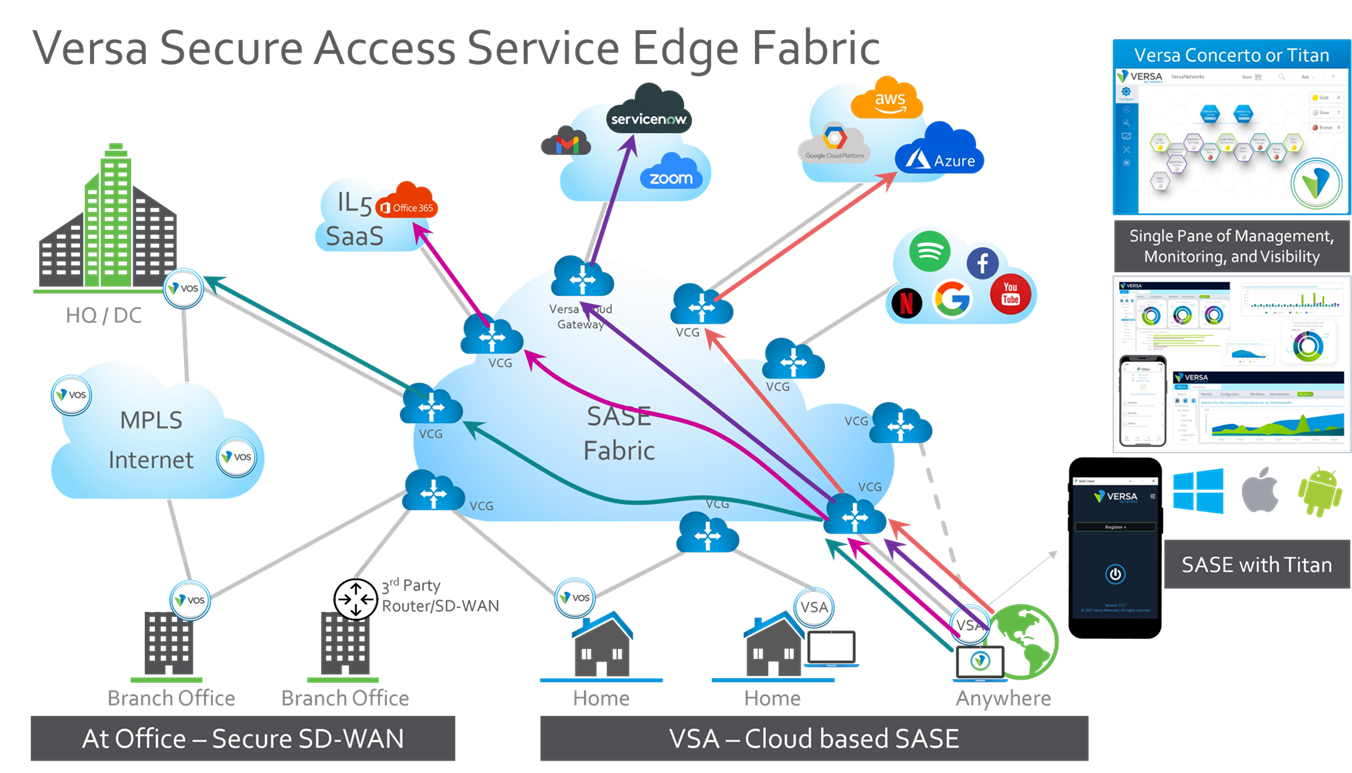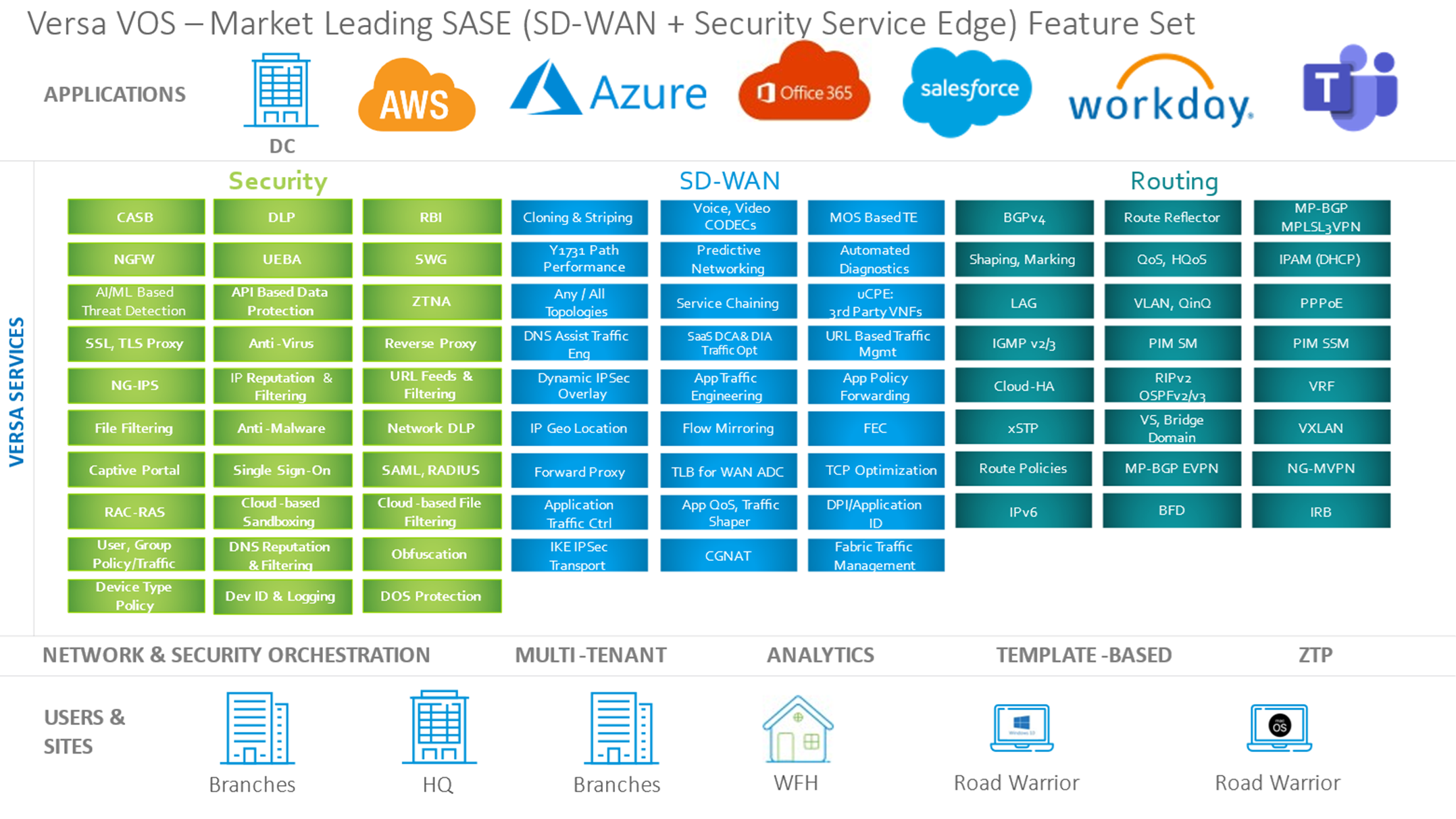SD-WAN and Secure Service Edge for DoD and Ultra-Secure Deployments
Versa Networks is a market leader in SD-WAN, SD-Security, and SASE technology, with over 120 service provider partners worldwide. In the United States (US), Versa’s largest partners include Verizon, Lumen, and Comcast. Versa has the largest number of Global SD-WAN deployments. Versa solution is responsible for the networking and security of many global mission-critical networks in the financial, banking, energy, satellite, maritime, retail, health care, and other verticals where the best user-to-application performance in the face of all types of failures and security are the primary focus.
Read the white paper here or Download the PDF by filling out the form.
Abstract
This white paper describes how the Versa SD-WAN, ZTNA, and SASE solutions are very well suited for satellite, maritime, and federal networks that operate in adverse and DDIL (Denied, Disrupted, Intermittent, and Limited) conditions and which often leverage NSA’s High Assurance Internet Protocol Encryption (HAIPE) or Commercial Solutions for Classified (CSfC)-based architectures.
Section 1: Gartner has recognized Versa in the upper right of the SD-WAN Magic Quadrant (MQ)
The Gartner MQ report included two subcategories where Versa placed #1:
- Critical Capabilities
- Large Complex Global Networks. Gartner has also produced a report on companies with the most SASE capabilities. Versa placed at the top of the Gartner SASE capabilities report delivering 13 out of 15 technologies identified by Gartner.
NSS Labs has tested Versa SD-WAN, NGFW (Next Generation Firewall), and NGIPS (Next Generation Intrusion Prevention System). Product efficacy with stopping attacks was very high, while the cost of Mbps secured was the lowest amongst OEMs.
Versa has married its native SD-WAN, SD-Security, and Multi-Cloud features to deliver a cohesive and comprehensive SASE and Multi-Cloud solution.
Some of the main differentiators between Versa and other solutions are:
- Integration of SD-WAN, SD-Security, and Multi-Cloud into a single platform.
- Single pane of management for SD-WAN, SD-Security, and Multi-Cloud.
- Unified policy management – One software stack (VOS) for on-premises, SASE cloud, and the edge.
- Multi-defense system-based threat protection and near real-time remediation.
- Zero Trust Network Access based on User, Group, Device Posture, Application, Content, Geo-Location, Entity Confidence Score, Security Tag associated with the source, and many more factors.
- Support for Secure Private Access, Secure Web Gateway (SWG), Cloud Access Security Broker services, Data Loss Prevention (DLP), Remote Browser Isolation (RBI), User Entity Behaviour Analytics, Security based on AI/ML, Dynamic Analysis of Malware using Sandboxing, and Next-Generation Unified Threat Management.
- VANI (AIOps) for Anomaly Detection, Traffic Prediction, Event Correlation, and Chatbot (Verbo).
- Optimal traffic steering and SaaS acceleration using Versa Traffic Engineered (TELS: Traffic Engineering Link State) SASE backbone.
- Dynamic Tenant & Virtual Gateway instantiation – elastic auto-scaling and network intelligence to meet real-time capacity demands.
- SD-WAN Lite for SASE Clients and Third-Party Routers.
- Single Pass architecture – unparalleled performance at scale.
- Hierarchical Multi-tenancy & granular Role Based Access Control (RBAC).
- Versatile Service Chaining of Virtual Network Functions (VNFs) and Physical Network Functions (PNFs).
- Support for big data analytics.
- Integration with multiple security intelligence sources, including Cyber Situational Awareness (SA) tools for expedient global dissemination and real-time enforcement.
Figure 2 shows a periodic chart of the routing, SD-WAN, and secure services edge features that Versa supports. Using these capabilities, Versa enables its customers to do the following:
- Deploy a secure traffic-engineered global SD-WAN and SASE network that can provide the best application experience for users and IoT devices, irrespective of their and applications’ locations. This is shown in Figure 1.
- Zero Trust Network Access based on User, Group, Device Posture, Application, Content, Geo-Location, Entity Confidence Score, Security Tag associated with the source, any layer3 to layer7 fields of the packet, and time of the day.
- Multi-defense system-based threat protection and near real-time remediation.


